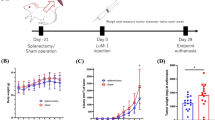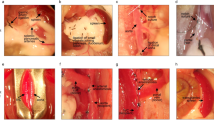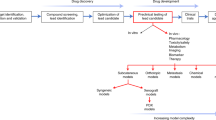Abstract
The spleens of rats bearing methylcholanthrene induced sarcomas are enlarged. This applies both to primary and to isotransplanted tumours. The spleen enlarges with increasing tumour size.
Splenomegaly is induced by skin homograft rejection, but spleen sizes do not reach those seen during tumour growth, even when the animals are chronically exposed to homologous skin. Sensitization of animals with small tumour homografts gives spleen sizes even greater than those of primary tumour growth.
Spleen histology in tumour bearing animals is comparable with that of homograft rejection.
The relation of splenomegaly to the presence of tumour specific antigen is discussed. The suggestion is advanced that the spleen size during tumour growth is determined by the product of reaction to foreign antigen, and of reticuloendothelial (phagocytic) activity.
This is a preview of subscription content, access via your institution
Access options
Subscribe to this journal
Receive 24 print issues and online access
$259.00 per year
only $10.79 per issue
Buy this article
- Purchase on Springer Link
- Instant access to full article PDF
Prices may be subject to local taxes which are calculated during checkout
Similar content being viewed by others
Rights and permissions
About this article
Cite this article
Blamey, R., Evans, D. Spleen Weight in Rats During Tumour Growth and in Homograft Rejection. Br J Cancer 25, 527–532 (1971). https://doi.org/10.1038/bjc.1971.67
Issue Date:
DOI: https://doi.org/10.1038/bjc.1971.67
This article is cited by
-
Splenic blood flow and intrasplenic flow distribution in rats
Pflügers Archiv European Journal of Physiology (1977)
-
Embryo-derived teratocarcinomas elicit splenomegaly in syngeneic host
Nature (1974)



